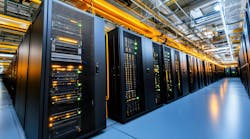Cloud Platforms Building ‘The World’s Computer’ to Drive Digital Change
As he announced record earnings powered by his company’s cloud computing business, Microsoft CEO Satya Nadella captured the wave of change sweeping the global IT landscape.
“What we are witnessing is the dawn of a second wave of digital transformation sweeping every company and every industry,” Nadella said. “We are building Azure as the world’s computer to support organizations growing cloud needs.”
The extraordinary growth of Microsoft and rival cloud platforms from Amazon Web Services and Google has been accelerated by the COVID-19 pandemic. As infrastructure developers race to keep pace with cloud demand, business from these “hyperscale” customers is driving record growth for the data center industry.
Cloud computing has become the fastest and most efficient way to deploy applications and services. As more IT workloads gravitate to cloud platforms, hyperscale computing is growing faster than all other IT sectors, and represents a growing chunk of business for the data center business.
“There were 111 new hyperscale data centers opened in the last eight quarters, with 52 of those coming onstream in 2020 despite COVID-19 causing a few logistical issues,” said John Dinsdale, a Chief Analyst at Synergy Research Group. “In addition to almost 600 operational data centers, we have visibility of a further 219 that are at various stages of planning or building, which is good news indeed for data center hardware vendors and wholesale data center operators.”
Data centers users leased a record 700-plus megawatts of data center capacity in 2020, and nearly three-quarters of that business came from hyperscale customers, up from 50 to 55 percent in recent deals.
“We believe hyperscale demand contributed to over 70% of the absorption in 2020, and think this trend will continue in 2021,” said datacenterHawk in its year-end analysis.
As IT capacity continues to grow, it will be increasingly concentrated in data center campuses operated by cloud providers and specialized data center developers. These campuses are becoming larger, creating server cities that will houses colossal collections of computers. In addition to their leasing activity, hyperscale operators are acquiring land for these future deployments. These cloud providers are both building and buying capacity, as seen in the evolution of Microsoft’s global network.
More Data Centers! Building, Buying and Growing Faster
The Microsoft Azure cloud computing platform posted growth of 50 percent in the company’s most recent quarter, boosting the pace of its gains as it reaches greater scale, with the company projecting $14.8 billion in revenue from the company’s “Intelligent Cloud” segment in the current quarter.
“We are seeing momentum in every industry,” said Nadella. “Digital capability is key to both resilience and growth. It’s no longer enough to just adopt technology. Businesses need to build their own technology to compete and grow. Microsoft is powering the shift with the world’s largest and most comprehensive cloud platform.”
That growth was clearly seen in data center market statistics, as Microsoft leased a massive 225 megawatts of capacity in nine leasing deals across four markets – Northern Virginia (146 MWs), Chicago (39 MWs), Silicon Valley (34 MWs) and Phoenix (6 MWs) – according to data from North American Data Centers.
That seems like a ton of capacity, but it’s not enough for Microsoft. The company is building multiple data center campuses in Northern Virginia and Phoenix, as well as build-to-suit projects in the Chicago market. Microsoft also recently bought 900 acres of property in Southern Virginia near a campus where it operates 1.1 million square feet of data center space, as well as 170 acres of land near its campuses in Iowa and a large piece of land near Atlanta.
All of the major cloud providers are also going global, adding new data centers to support the growing focus on global business and data sovereignty. Microsoft is investing to bring cloud regions to seven new countries in Asia, Europe and Latin America.
Expanding the Vocabulary of Scale
The scale of the cloud is huge and getting even huger. Google refers to its data centers as “warehouse-scale computers,” and describes its data center operations in depth in a recent podcast series called “Where the Internet Lives.”
Microsoft and Google are joined by Amazon Web Services and Facebook in the top tier of cloud spenders, followed by Apple and Chinese providers Alibaba and Tencent, according to Synergy’s data. Hyperscale companies spent $99 billion in capital expenditures in the first three quarters of 2020, with most of that going to data center capacity, according to Synergy.
This shift to cloud has been accelerated by the pandemic. “I think one of the things that we’re seeing is the COVID impact has put a lot of constraints on our all our customers,” said Nadella. “But the one structural change is that digital technology is becoming critical even for core resilience and business continuity and to deal with what is going to be a structurally changed customer behavior and expectations.”
The COVID-19 pandemic also creates challenging conditions for data center construction teams and the supply chain that supports them. While there have been delivery delays in select markets, Synergy’s Dinsdale noted that the industry completed 52 new hyperscale facilities in 2020.
“That is testament to the ongoing robust growth in the digital services that are driving those investments – particularly cloud computing, SaaS, e-commerce, gaming and video services,” he said. “As these companies go from strength to strength, they need an ever-larger footprint of data centers to support their rapidly expanding digital activities.”
About the Author


